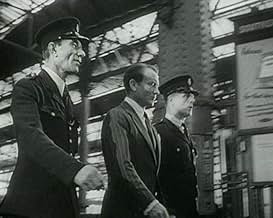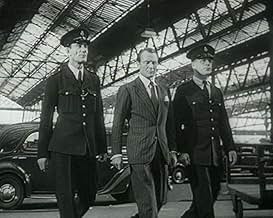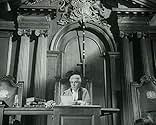NOTE IMDb
7,0/10
1,4 k
MA NOTE
Ajouter une intrigue dans votre langueReleased from prison after twelve years, a wrongfully convicted British man seeks revenge on the witnesses who lied at his trial.Released from prison after twelve years, a wrongfully convicted British man seeks revenge on the witnesses who lied at his trial.Released from prison after twelve years, a wrongfully convicted British man seeks revenge on the witnesses who lied at his trial.
- Réalisation
- Scénario
- Casting principal
Michael Martin Harvey
- Jackson
- (as Michael Martin-Harvey)
Avis à la une
When I first saw this film about 5 yrs ago I was excited because I was unaware of the film and I read a preview in the TV listings that said some was filmed in Gravesend,my home town. The location filming was excellent but certain things grated on me like the tea shop in the middle of nowhere on the marshes down river from Gravesend where any passing trade could not have supported a business also the detective in regulation raincoat and hat who followed John Mills into the tea shop.I have now watched the film again today and enjoyed it much more and would say it is a little gem of the time and genre. I am still thrilled by the location scenes in Gravesend,not quite Carol Reed's Third Man but very atmospheric, the street near the river is much changed today but the small church like structure clearly seen in background shots was a seaman's mission and is still there today also in one shot you can see the spire of St Georges,Gravesend's parish church which is where Princess Pocohontas is buried.I feel John Mills really conveys the feeling of a man with a 12 year grudge and the scenes with Ilse where the grudge melts are beautifully portrayed.In his autobiography John Mills describes the film as "an extremely good thriller" but infers that director Bob Hamer had a drink problem and describes him as twice while filming night shots he fell into the Thames while walking backwards looking through a viewfinder!
John Mills tracks down the real culprit of the murder he was sent to jail for in this tense British drama of exile and return. The real murderer is now a comfortable businessman, and the visual contrasts between his dubious offices in the London docks and Mills' derelict boat far out on the river estuary gives a resonance to the film it would be hard to find in a modern setting. Freed from jail but still imprisoned by the past, Mills' character spurns the touching companionship of another refugee on the Kent marshes (Eva Bergh) about whose past we know nothing, but it seems to be destiny that has brought them together. This is one of the few films that resolves a labyrinthine revenge-story without the plot becoming mechanical, and the bleak monochrome visuals are part of its emotional power.
Robert Hamer was not a prolific director; only around a dozen films are credited to him, and because of his serious alcohol problem there is some doubt as to the extent to which he was responsible for some of those, especially his final film, "School for Scoundrels". His career has been described as "the most serious miscarriage of talent in the postwar British cinema", yet during that relatively brief career he was responsible for some of the best British films of the forties and fifties. He is today best remembered for that brilliant Ealing comedy, "Kind Hearts and Coronets", but was capable of producing serious movies as well as comedies; his "It Always Rains on Sunday", for example, is a crime thriller showing the influence of the film noir style.
With "The Long Memory" from 1952, Hamer moves even closer in the direction of noir. The plot, based on a novel by Howard Clewes, owes something to Dumas' "The Count of Monte Cristo". A young man is sentenced to imprisonment for a crime he did not commit. Upon his release, he sets out to get revenge upon those responsible for his wrongful conviction, including his treacherous fiancée. The hero, Philip Davidson spends 12 years in prison after being wrongly convicted for murder, a conviction procured by perjured evidence given by his fiancée Fay, her father Captain Driver and a man named Tim Pewsey. Fay's motive for perjuring herself was to protect her elderly father, who had become mixed up in a criminal enterprise with Pewsey and another man named Boyd, the actual murderer.
Some purists maintain that film noir was an exclusively American genre, but I have never concurred with that opinion, as there were also a number of British films (and indeed French ones such as "Les Diaboliques") which share the characteristics of noir, and this is one of them. One of the classic noir features is the morally ambiguous lone male hero, and John Mills' Davidson is certainly a character of that type; had this been a Hollywood film he could have been played by Bogart or Mitchum. Although he has been the victim of a grave injustice, and in that sense has a claim on our sympathy, his experiences have made him, in many ways, an unsympathetic character, vindictive and unsociable. After his release he goes to live in a disused barge on the marshes, a dwelling reminiscent of Richard Widmark's wooden shack by the riverside in a great American noir, "Pickup on South Street". Davidson's closest friend is another of life's victims, wartime refugee named Ilse, and he has other allies in his fight to clear his name, including Craig, a journalist, and Superintendent Bob Lowther, a policeman who believes that a miscarriage of justice may have occurred. Lowther's position, however, is made difficult by the fact that he is married to Fay, the woman whose lies were responsible for Davidson's conviction.
Other noir characteristics present in this film include dramatic, expressionistic black-and-white photography and a gritty urban setting, with the dingy backstreets of Gravesend (a riverside port east of London and not normally regarded as an important cinematic location) here fulfilling the role which in an American noir would played by Los Angeles or New York. The setting is not, however, exclusively urban; many scenes were shot on the North Kent Marshes, the area around Gravesend and Rochester immortalised by Dickens in "Great Expectations". This marshland landscape around the Thames and Medway Estuaries, an area which I know well, is not conventionally beautiful in the way in which, say, the Lake District or the Cotswolds are beautiful. Indeed, it can often be bleak and forbidding, but it is also powerfully atmospheric. It makes a fitting setting for this tale of crime and revenge and gives the film has a strong sense of place. The film ends with justice being done, but here too there is a note of doubt and uncertainty; it is not, for example, clear whether Lowther's marriage to Fay can survive the revelations about her past.
The most famous British noir is probably "The Third Man", a British-made film even though it is set in Vienna. "The Long Memory" is less well-known, but with a strong performance from Mills in the leading role, its powerful storyline and Hamer's atmospheric direction I would place it in the same class as Carol Reed's masterpiece. 9/10
With "The Long Memory" from 1952, Hamer moves even closer in the direction of noir. The plot, based on a novel by Howard Clewes, owes something to Dumas' "The Count of Monte Cristo". A young man is sentenced to imprisonment for a crime he did not commit. Upon his release, he sets out to get revenge upon those responsible for his wrongful conviction, including his treacherous fiancée. The hero, Philip Davidson spends 12 years in prison after being wrongly convicted for murder, a conviction procured by perjured evidence given by his fiancée Fay, her father Captain Driver and a man named Tim Pewsey. Fay's motive for perjuring herself was to protect her elderly father, who had become mixed up in a criminal enterprise with Pewsey and another man named Boyd, the actual murderer.
Some purists maintain that film noir was an exclusively American genre, but I have never concurred with that opinion, as there were also a number of British films (and indeed French ones such as "Les Diaboliques") which share the characteristics of noir, and this is one of them. One of the classic noir features is the morally ambiguous lone male hero, and John Mills' Davidson is certainly a character of that type; had this been a Hollywood film he could have been played by Bogart or Mitchum. Although he has been the victim of a grave injustice, and in that sense has a claim on our sympathy, his experiences have made him, in many ways, an unsympathetic character, vindictive and unsociable. After his release he goes to live in a disused barge on the marshes, a dwelling reminiscent of Richard Widmark's wooden shack by the riverside in a great American noir, "Pickup on South Street". Davidson's closest friend is another of life's victims, wartime refugee named Ilse, and he has other allies in his fight to clear his name, including Craig, a journalist, and Superintendent Bob Lowther, a policeman who believes that a miscarriage of justice may have occurred. Lowther's position, however, is made difficult by the fact that he is married to Fay, the woman whose lies were responsible for Davidson's conviction.
Other noir characteristics present in this film include dramatic, expressionistic black-and-white photography and a gritty urban setting, with the dingy backstreets of Gravesend (a riverside port east of London and not normally regarded as an important cinematic location) here fulfilling the role which in an American noir would played by Los Angeles or New York. The setting is not, however, exclusively urban; many scenes were shot on the North Kent Marshes, the area around Gravesend and Rochester immortalised by Dickens in "Great Expectations". This marshland landscape around the Thames and Medway Estuaries, an area which I know well, is not conventionally beautiful in the way in which, say, the Lake District or the Cotswolds are beautiful. Indeed, it can often be bleak and forbidding, but it is also powerfully atmospheric. It makes a fitting setting for this tale of crime and revenge and gives the film has a strong sense of place. The film ends with justice being done, but here too there is a note of doubt and uncertainty; it is not, for example, clear whether Lowther's marriage to Fay can survive the revelations about her past.
The most famous British noir is probably "The Third Man", a British-made film even though it is set in Vienna. "The Long Memory" is less well-known, but with a strong performance from Mills in the leading role, its powerful storyline and Hamer's atmospheric direction I would place it in the same class as Carol Reed's masterpiece. 9/10
This is an excellent British film, which has managed to pass the test of time, and still stands today as an absorbing & well executed piece of work. The story line is strong, and the locations are particularly memorable, especially the bleak & foreboding Kent coastline which adds significantly to the brooding atmosphere. The performances are uniformly excellent, with the sole exception of Elizabeth Sellars who barely changes expression throughout. John Mills gives one of his most intense performances in the lead role, and demonstrates once again what an extremely fine actor he always was. The direction & editing are first class, and the film never falters in holding the attention. For fans of the genre, this is not to be missed.
9jugh
I have seen "The Long Memory" twice, and was sufficiently impressed (and like John Mills) that I bought the book when I found it. After seeing the film a second time I then started reading the book. To my delight (that's how I like films) it was close to the film, and I realized that much of the quality of the film, beyond its strong visual imagery of London dockside slums, damaged by the Blitz (you have to know this: there is no sign saying "house flattened by bomb"), and post- war austerity (rationing continued in Britain into the early 1950s!), is directly due to the book author Howard Clewes (about whom little is available on the internet).
Despite not LOOKING like the author described him, John Mills acts the character described by the author, as do the rest of the cast.
The post-World-War-II setting is crucial to appreciating the bleakness of the film. Life was tough then, for many British, and even more so for Displaced People -- war survivors and immigrants from Europe. Petty crime was rife. In fact things were probably tougher than during the flashback sequence to the Depression, when the young Mills character is accidentally drawn into cross-Channel smuggling of wanted criminals, and contraband.
The old "beachcomber's" singing of a traditional English folksong is a haunting addition to the film that does not appear in the book.
Despite not LOOKING like the author described him, John Mills acts the character described by the author, as do the rest of the cast.
The post-World-War-II setting is crucial to appreciating the bleakness of the film. Life was tough then, for many British, and even more so for Displaced People -- war survivors and immigrants from Europe. Petty crime was rife. In fact things were probably tougher than during the flashback sequence to the Depression, when the young Mills character is accidentally drawn into cross-Channel smuggling of wanted criminals, and contraband.
The old "beachcomber's" singing of a traditional English folksong is a haunting addition to the film that does not appear in the book.
Le saviez-vous
- AnecdotesMany of the houses shown in this movie were demolished soon afterwards.
- GaffesAfter Craig is pushed face first into a muddy hold by Davidson he is next seen with a dirty overcoat but his face and hair are completely spotless.
Meilleurs choix
Connectez-vous pour évaluer et suivre la liste de favoris afin de recevoir des recommandations personnalisées
- How long is The Long Memory?Alimenté par Alexa
Détails
- Date de sortie
- Pays d’origine
- Langue
- Aussi connu sous le nom de
- Dugo sećanje
- Lieux de tournage
- Gravesend, Kent, Angleterre, Royaume-Uni(Queen Street and Granby Road were locations for the two Tim Pewsey residences.)
- Sociétés de production
- Voir plus de crédits d'entreprise sur IMDbPro
- Durée
- 1h 36min(96 min)
- Couleur
- Rapport de forme
- 1.33 : 1
Contribuer à cette page
Suggérer une modification ou ajouter du contenu manquant
































